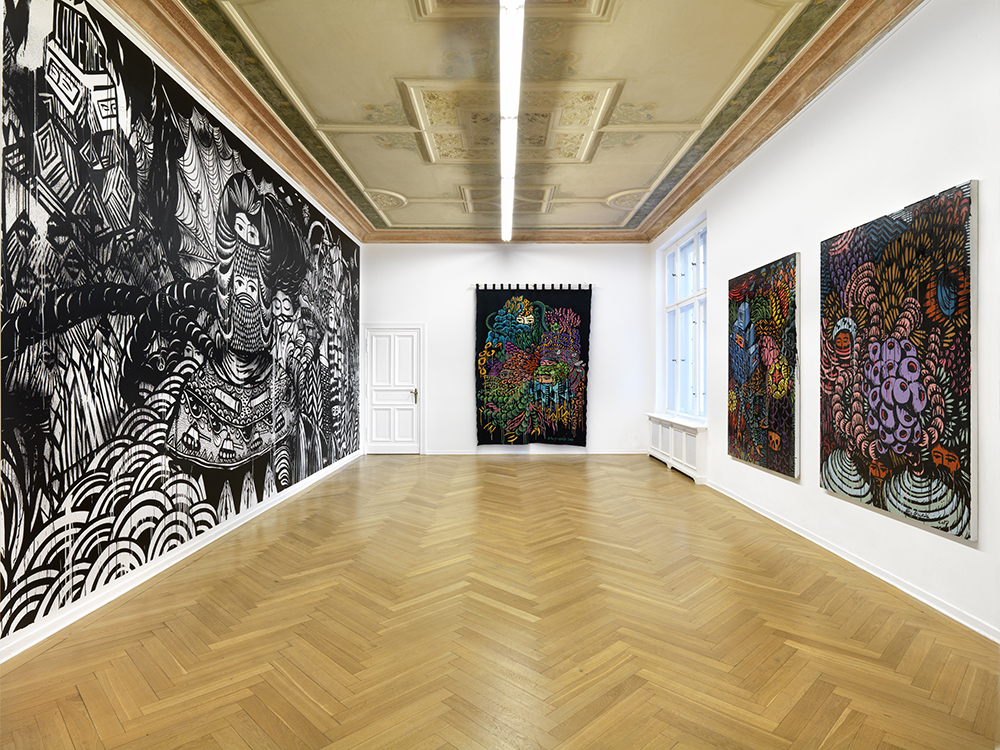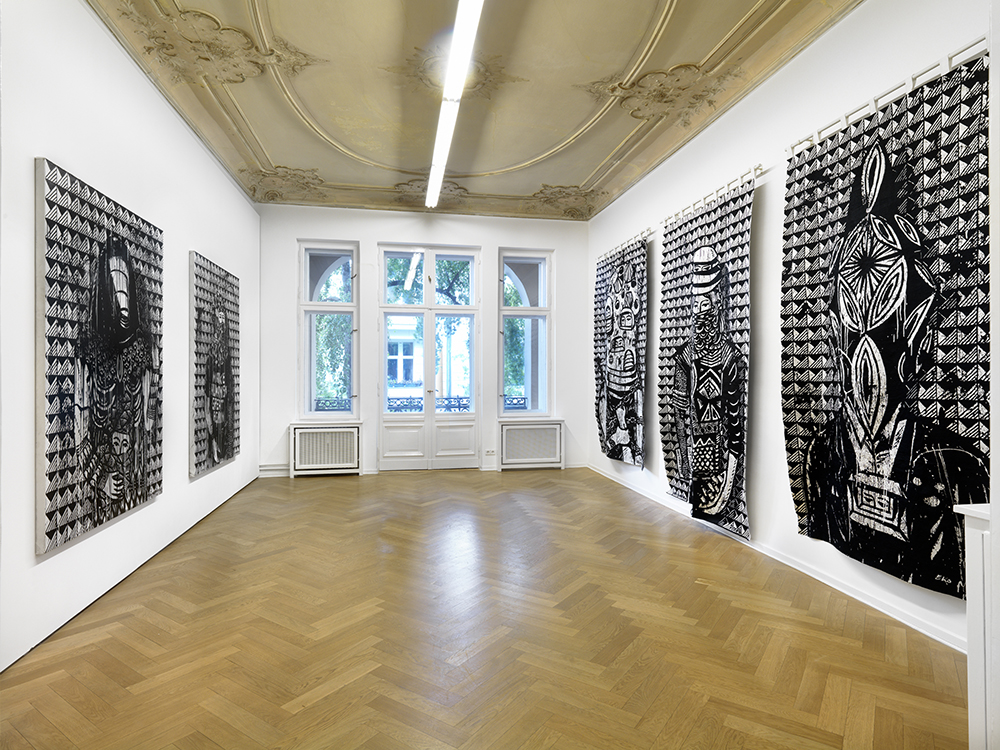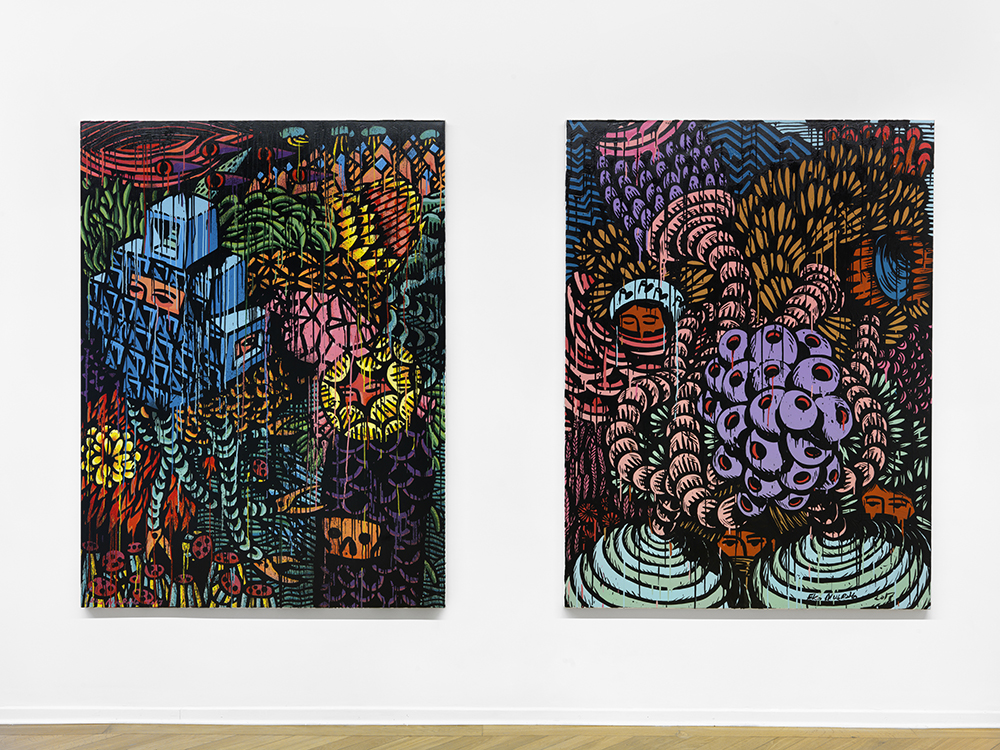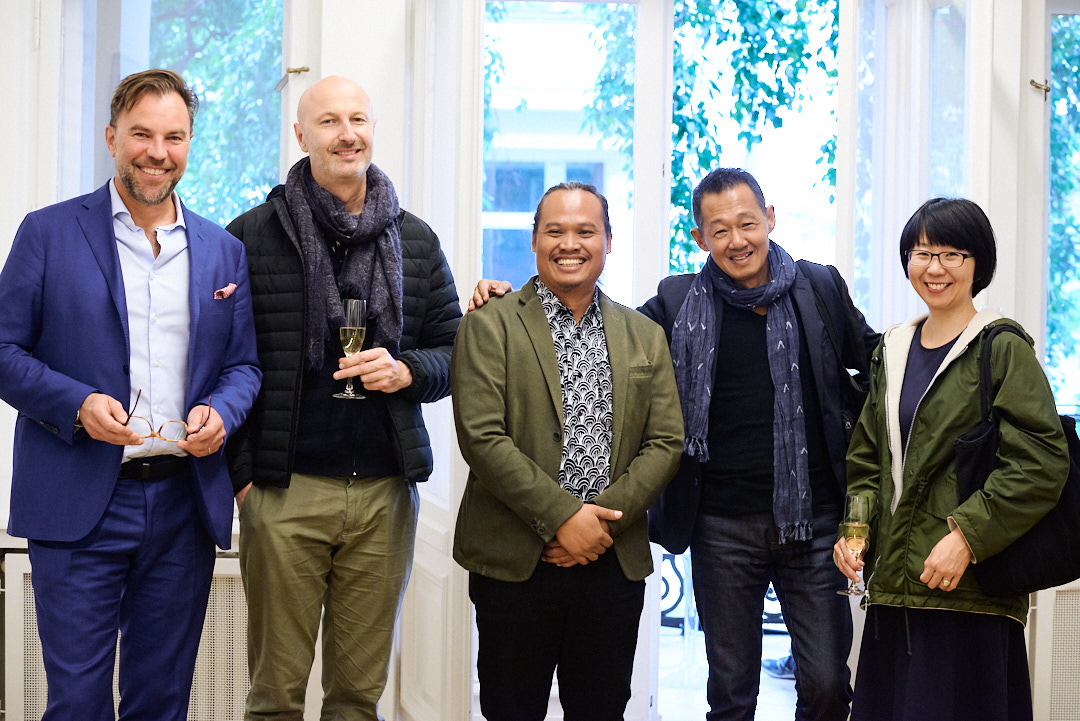VISIONS OF DEMOCRACY
In his arresting solo presentation “Plastic Democracy” at Arndt Art Agency, Berlin, leading Indonesian artist Eko Nugroho presents viewers with the topic of democracy within a global context that speaks to his own Indonesian environment. Exploring binary ideas through black and white imagery contrasted with vibrant colourful organic compositions across paintings, murals and embroideries, Nugroho offers A3 Editorial an exclusive insight into his inspiration for this project and the ongoing challenges he takes on as an artist.
 Installation view: Eko Nugroho, Plastic Democracy, Arndt Art Agency, Berlin (2018)
Installation view: Eko Nugroho, Plastic Democracy, Arndt Art Agency, Berlin (2018)
Plastic Democracy is the title of your presentation in Berlin. Could you discuss your inspiration and starting point for this project?
The last exhibition I held with Arndt Fine Art in Berlin was in 2012. It had a totally different title “Threat as a Flavour” but it was concerned with the same topic of democracy itself – what is happening today regarding democracy specifically in Indonesia, but also what is happening in the global sense.
So you are dually investigating what that means for us across the world as a global community, but also what that might mean for individuals in local settings.
Yes exactly. So with the title “Plastic Democracy”, I like to talk about the idea of “plastic” itself which represents a big problem in our lives, posing a threat to the future of our environment. When you combine this with “democracy” you can also consider that democracy itself is man-made and that is also presents situations and problems that are difficult to solve.
Many people say or believe they have the solution – but a lot of people are saying and talking in this way without any action or conviction. For example, in Indonesia, we have only found ourselves in a democracy since 1998 after the fall of Suharto regime. We hold this status of democracy, this period of transition “Reformasi” as the crown of our country and something to be really proud of. Becoming democratic and conveying this ideology is still in process and we are still trying to understand democracy itself. I lived for 21 years under different system of military control. It was a totally different way of living. It was a scary period where you could not criticise anything and everything was heavily censored.
 Installation view: Eko Nugroho, Plastic Democracy, Arndt Art Agency, Berlin (2018)
Installation view: Eko Nugroho, Plastic Democracy, Arndt Art Agency, Berlin (2018)
In your compositions you depict anonymous faces amongst imagery that towers above, over, and even consumes these individuals. What do theses faces represent within your paradigm of democracy.
It represents us. It’s you, it’s me, everyone. These faces are presented within the composition of a kind of a Batik style, with Batik fabric motifs and patterning that in visuals and text articulate ideas about war, peace and hope.
You successfully achieve in communicating these complex topics in extremely uncomplicated, direct visuals. You are never shy to tackle big topics and this is not the first time you have decided to engage with political issues and power systems in your work.
Politics is above and across everything. It is in business, in art, in everything. Politics is always in the background. For me it is attractive to explore these topics.
 Left-right: Matthias Arndt, A3 Founder; Perry Pada, Chargé d’Affairs, Embassy of the Republic of Indonesia, Berlin; Eko Nugroho
Left-right: Matthias Arndt, A3 Founder; Perry Pada, Chargé d’Affairs, Embassy of the Republic of Indonesia, Berlin; Eko Nugroho
Your work is characteristically known for very colourful content. In this show, you are employing very strong black and white visuals in your murals, but also some embroideries and paintings. What is your motivation behind this choice of a monochrome palette?
For me, this is the most extreme way in my mind to present ideas about the good and the bad, the right and the wrong. Binary ideas. When I make this work, I am aiming to protest about something, in doing so, I decided the most direct and simple way to do this was to present my ideas visually in black and white. It can be seen as chaotic, but in fact it is also colourful through the flavour of the expressive lines alone. With a black and white palette the image also becomes more like democracy in a way. These monochrome works reflect on the perceived simplicity of democracy ‘on paper’, as a system. Black and white, true and false, however, in between black and white – black bleeds into white and white drips onto black in my canvases and embroideries presenting democracy in Indonesia as far from simple. It is also a challenge to work only in black and white. I have found that working in this way has also forced me to make new decisions and find new solutions about the way I work and gives me a lot of energy.
 Installation view: Eko Nugroho, Plastic Democracy, Arndt Art Agency, Berlin (2018)
Installation view: Eko Nugroho, Plastic Democracy, Arndt Art Agency, Berlin (2018)
In your embroideries, this process is obviously a lot more premeditated as opposed to the very directness of brushstrokes for example, however your embroideries do appear to convey this same sense of flow with simulated drips. Could you describe your working process with your embroideries as I understand your starting point is in fact a painting.
Yes, so I start with a painting. I paint directly on a plain canvas and then I select threads for the embroidery with the same colour and the threads are sewn directly on top the brushstrokes. The thread of the embroidery is sewn over the top, translating these paint “drip” elements. The painting is then in fact encased inside the embroidery. A playful surprise.
Part of the importance of the production of my embroideries is also about engaging the artist with society. I connected with local craftsperson who had lost their jobs with the advent of computerised technology in the embroidery industry. As the industry changed, people become only interested in the fast digital production of embroideries en masse and this manually operated craft industry became lost. With my embroidery work I aim to bring together these craftspeople with their experience and skills as a way of collaboration in order and expose them to art, but also to share and learn from each other. In the beginning, they only knew how to embroider in small sizes such as 1 x 1m, but I tried to push them into new ways of working and experimenting in my studio to find new solutions and new ways of working. Now together we can produce larger 6 x 5 metres embroideries. I have developed the embroidery studio since 2007.

 Eko Nugroho x DGTMB Merchandise Pop-up Project in front of Arndt Art Agency during Gallery Weekend Berlin 2018
Eko Nugroho x DGTMB Merchandise Pop-up Project in front of Arndt Art Agency during Gallery Weekend Berlin 2018
How many people are you providing jobs for in your studio across the board?
In total, across the many different divisions of my artistic practice there are 30 people. DGTMB Merchandise Project, Wayang Bocor performance group, Eko Nugroho Art Class and my Studio team.
And that is very important to you isn’t it?
Yes it is. Because there are many different projects, from the embroideries, my art studio itself, DGTMB, my shadow puppets project and arts education for children program. It is all about art and bringing people together to learn and have fun.
It makes me think that you get bored easily. You are always re-inventing.
If I feel bored, then I have to find another idea!
 Installation view: Eko Nugroho, Plastic Democracy, Arndt Art Agency, Berlin (2018)
Installation view: Eko Nugroho, Plastic Democracy, Arndt Art Agency, Berlin (2018)
Can you talk about some the imagery in these very colourful paintings in the show? They are very organic.
These colour burst works, such as the “Garden full of Blooming Democracy” series present democracy as a sprawling garden – where politics, culture and religion grow alongside, in competition and entangle one another like climbing vines, wildflowers and weeds. Colours offset, clash and contrast; as diverse as international cultures and people. These colours are still contained in strong black lines, demonstrating the pressure of containment of so much diversity and difference in systems of democracy and questions if the strength of people without systems of democracy will ever be enough while we wait for these systems to stick. It is like a plant that grows unpredictably – like the things found in your backyard. I use this imagery to talk about democracy itself again: democracy is also colourful and multifaceted. In Indonesia specifically, everyone was talking about democracy, but at the same time, everyone was also ignoring how it was being upheld. With these colourful works I aim to express many different things in the name of democracy. The black outlining structure unites all of these images and is indeed chaotic, but also beautiful. That is democracy and we cannot predict how it may evolve.
Do you think your work is positive.
I try and work with optimism on my side. Bad things have happened and I always try and look at what we can learn from those things. I try to bring this energy into my work.
So you see it as an important role for you as an artist to convey these messages?
First of all, I convey these messages for myself and from this I hope that people feel and think about these ideas located in my works. But I think starting in a positive way allows for a lot of opportunity.
 Plastic Democracy exhibition opening, Arndt Art Agency, Berlin, 27th April 2018
Plastic Democracy exhibition opening, Arndt Art Agency, Berlin, 27th April 2018
You always integrate something from a local setting where you work when you travel around the world. What has been your take away from being in Berlin?
I think because I am not staying long in Berlin this time, I appropriated some quite symbolic imagery from historical things, such as the Berlin Victory Column monument that you can see here in my large mural “Plastic Democracy #1”. It conveys a strong message for my topic through this mural also for people from Berlin. After the show this mural will be gone, the idea of the painting on the wall reminds me of the wall itself in Berlin and the dark and scary history of Berlin. In Indonesia, I think we have the same feeling, we divide the past by a wall so to speak – we are divided by the ideologies such as religion, politics, many different things. By the black and the white. These are other types of walls. You can also discern this in my text from my piece “Plastic Democracy #3”: “We offer trust, you give us borders”. It aims to convey that a lot of people try to do good, but a lot of people are also doing bad. This kind of chaos is so human.
For me, you are just posing the questions for your audiences to consider.
It is exactly like that.


